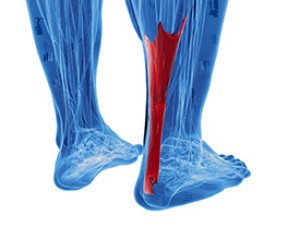
The Achilles tendon is located in the back of the lower leg and connects the heel to the calf muscles. An injury can cause this tendon to become torn or inflamed, which often produces severe pain and discomfort. People who increase speed and distance too quickly while running may be prone to incurring an Achilles tendon injury, and this and similar activities will have to temporarily stop as the tendon heals. The Achilles tendon is responsible for pointing and flexing the foot and is instrumental while walking and running. Treatment generally begins with resting the affected foot, and it may help to take over the counter pain medications for mild relief. Many people will seek medical care for this type of injury, which can start by having a diagnosis performed. This can consist of having an X-ray done, which can determine if there is a bone injury. Once the Achilles tendon has healed, mild stretches can be performed, which may help to restore strength to the leg. If you have experienced this type of injury, it is strongly suggested that you confer with a podiatrist who can help you to manage this condition.
Achilles tendon injuries need immediate attention to avoid future complications. If you have any concerns, contact Dr. Lubrina Bryant of District Podiatry, PLLC. Our doctor can provide the care you need to keep you pain-free and on your feet.
What Is the Achilles Tendon?
The Achilles tendon is a tendon that connects the lower leg muscles and calf to the heel of the foot. It is the strongest tendon in the human body and is essential for making movement possible. Because this tendon is such an integral part of the body, any injuries to it can create immense difficulties and should immediately be presented to a doctor.
What Are the Symptoms of an Achilles Tendon Injury?
There are various types of injuries that can affect the Achilles tendon. The two most common injuries are Achilles tendinitis and ruptures of the tendon.
Achilles Tendinitis Symptoms
Rupture Symptoms
Treatment and Prevention
Achilles tendon injuries are diagnosed by a thorough physical evaluation, which can include an MRI. Treatment involves rest, physical therapy, and in some cases, surgery. However, various preventative measures can be taken to avoid these injuries, such as:
If you have any questions please feel free to contact our office located in Washington, D.C . We offer the newest diagnostic tools and technology to treat your foot and ankle needs.